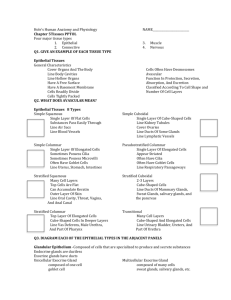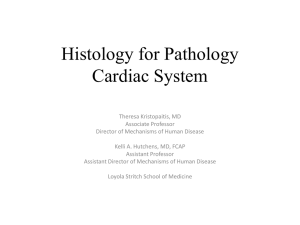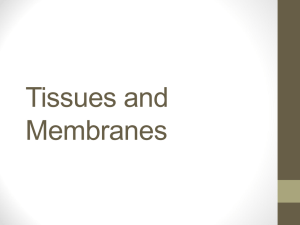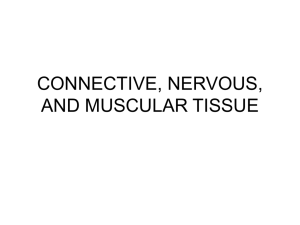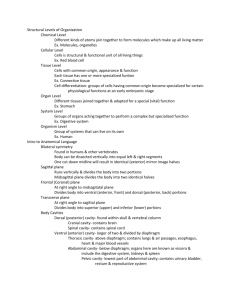BIOLOGY II
advertisement
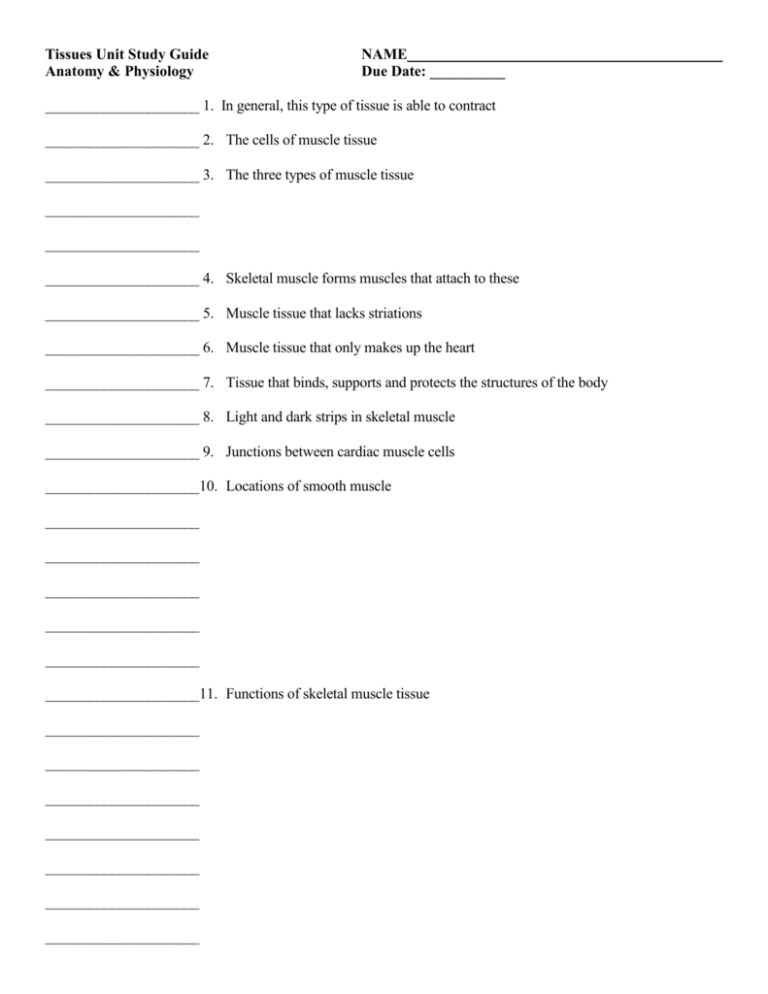
Tissues Unit Study Guide Anatomy & Physiology NAME Due Date: __________ _____________________ 1. In general, this type of tissue is able to contract _____________________ 2. The cells of muscle tissue _____________________ 3. The three types of muscle tissue _____________________ _____________________ _____________________ 4. Skeletal muscle forms muscles that attach to these _____________________ 5. Muscle tissue that lacks striations _____________________ 6. Muscle tissue that only makes up the heart _____________________ 7. Tissue that binds, supports and protects the structures of the body _____________________ 8. Light and dark strips in skeletal muscle _____________________ 9. Junctions between cardiac muscle cells _____________________10. Locations of smooth muscle _____________________ _____________________ _____________________ _____________________ _____________________ _____________________11. Functions of skeletal muscle tissue _____________________ _____________________ _____________________ _____________________ _____________________ _____________________ _____________________ Tissues Unit Study Guide Anatomy & Physiology NAME Due Date: __________ _____________________12. Muscle tissue that allows the body to move _____________________13. Locations of nervous tissue _____________________ _____________________ _____________________14. The highly specialized cells of nervous tissue _____________________15. Functions of nervous tissue _____________________ _____________________ _____________________16. Cellular processes that transmit electrical signals _____________________17. Cells that support and bond components of nervous tissue _____________________18. Cellular processes that receive incoming electrical signals _____________________19. The most abundant tissue by weight _____________________20. The most abundant tissue by location _____________________21. Consists of protein fibers and a ground substance _____________________22. The three major cell types of connective tissue _____________________ _____________________ _____________________23. Large, star-shaped and fixed cells within connective tissue _____________________24. Another name for macrophages _____________________25. Connective tissue cells that are usually found near blood vessels _____________________26. Function of fibroblasts _____________________27. Two compounds produced by mast cells _____________________ _____________________28. Functions of macrophages _____________________ Tissues Unit Study Guide Anatomy & Physiology NAME Due Date: __________ _____________________29. Four diseases that can result from disruption of the extracellular matrix _____________________ _____________________ _____________________30. The origin of macrophages _____________________31. Compound that prevents blood clotting _____________________32. Means to “eat stuff” _____________________33. Compound that promotes inflammation, allergies, asthma and hay fever _____________________34. The three types of fibers produced by fibroblasts _____________________ _____________________ _____________________35. Fibers that connect bones to bones _____________________36. Fibers that connect muscles to bones _____________________37. Thick threads of the protein collagen _____________________38. Connective tissue cells that can move throughout the body _____________________ _____________________39. Two classifications of collagenous fibers _____________________ _____________________40. Two examples of collagenous fibers _____________________ _____________________41. Major structural protein of the body _____________________42. Contains an abundance of collagenous fibers and is also called white fibers _____________________43. Contains a sparse amount of collagenous fibers _____________________44. Consists of fibers that are easily stretched or deformed by rebound to their original shapes and lengths _____________________45. Consists of highly branched, thin collagenous fibers Tissues Unit Study Guide Anatomy & Physiology NAME Due Date: __________ _____________________46. A spring-like protein _____________________47. Location of reticular fibers _____________________48. The two major divisions of connective tissue _____________________ _____________________49. Locations of elastic fibers _____________________ _____________________50. Components of connective tissue proper _____________________ _____________________ _____________________51. Consists of delicate, thin membranes throughout the body _____________________52. Components of specialized connective tissue _____________________ _____________________ _____________________53. Also known as fat _____________________54. Consists of thin, reticular fibers in a three-dimensional network _____________________55. Locations of areolar connective tissue _____________________ _____________________56. The cells of adipose connective tissue _____________________57. Function of reticular connective tissue _____________________58. Consists of many closed packed, thick collagenous fibers, a fins network of elastic fibers and a few fibroblasts _____________________59. Consists of fibers that are thicker, interwoven and randomly organized Tissues Unit Study Guide Anatomy & Physiology NAME Due Date: __________ _____________________60. Locations of adipose tissue _____________________ _____________________ _____________________ _____________________ _____________________ _____________________ _____________________61. Functions of dense regular connective tissue _____________________ _____________________62. Location of dense irregular connective tissue _____________________63. Consists of yellow, elastic fibers in parallel strands or branching networks _____________________64. A rigid connective tissue that has chondrocytes _____________________65. Locations of elastic connective tissue _____________________ _____________________ _____________________ _____________________ _____________________67. Functions of cartilage _____________________ _____________________ _____________________ _____________________ _____________________68. Cells that make and maintain cartilage _____________________69. Function of elastic cartilage _____________________70. Location of chondrocytes Tissues Unit Study Guide Anatomy & Physiology NAME Due Date: __________ _____________________71. The three types of cartilage _____________________ _____________________ _____________________72. Found in the jaw, knee meniscus and intervertebral discs _____________________73. Found at the end of bones, attaches the ribs to the sternum and part of the nose _____________________74. Found in the outer ear, epiglottis and larynx _____________________75. Another name for bone _____________________76. Bone cells _____________________77. Functions of bone _____________________ _____________________ _____________________78. One unit of bone tissue _____________________79. The only liquid connective tissue _____________________80. Location of bone cells _____________________81. The narrow channel at the center of each lamellae _____________________82. Bone matrix _____________________83. A system of interconnecting canals that connects lacunae and Haversian canals _____________________84. The four components of blood _____________________ _____________________ _____________________ _____________________85. Groups or layers of similar cells with a common function _____________________86. Structures between cells that connect them by their cell membranes _____________________87. Junctions found lining the inside of the digestive tract & capillaries of the brain Tissues Unit Study Guide Anatomy & Physiology NAME Due Date: __________ _____________________88. Three types of intercellular junctions _____________________ _____________________ _____________________89. Type of junctions found in epithelial, cardiac & smooth tissues _____________________90. The study of the factors that contribute to the spread & frequency of disease within the human population _____________________91. Type of junctions found in heart muscle and the muscles of the digestive tract _____________________92. These are membrane proteins that interlock between cells _____________________93. This type of tissue covers body surfaces and organs _____________________94. A thin, nonliving layer that anchors epithelial tissue to connective tissue _____________________95. Intermediate filaments that sew membranes together _____________________96. Epithelial tissue always has a ____________ surface _____________________97. The two ways epithelial tissue is classified _____________________ _____________________98. These create channels to allow materials to flow between cells _____________________99. Thin, flattened cell shape _____________________100. Elongated cell shape _____________________101. Cube-like cell shape _____________________102. A single layer of epithelial cells _____________________103. Two or more layers of epithelial cells _____________________104. Type of tissue that lines air sacs of the lungs, forms walls of capillaries, and lines blood & lymph vessels _____________________105. Type of tissue that protects underlying tissues and contains goblet cells _____________________106. Type of tissue that lines the thyroid gland, covers the ovaries, lines the kidney tubules and the ducts of some glands _____________________107. Cells that secrete mucous Tissues Unit Study Guide Anatomy & Physiology NAME Due Date: __________ _____________________108. Extensions from the free surfaces of cells that move constantly _____________________109. Type of tissue that lines the passages of the respiratory system _____________________110. Type of tissue found in the outermost layer of your skin _____________________111. Type of tissue that lines the ducts of the mammary, sweat, & salivary glands _____________________112. Type of tissue that is specialized to change in response to increased tension _____________________113. Type of tissue that is only found in the male urethra & the larger ducts of the exocrine glands _____________________114. Tissue that is composed of cells specialized to produce and secrete substances _____________________115. Two main types of glands _____________________ _____________________116. Glands that secrete their products into ducts _____________________117. Locations of transitional epithelium _____________________ _____________________ _____________________118. Glands that secrete their products into tissue fluid or blood _____________________119. Four ways that exocrine glands are classified _____________________ _____________________ _____________________ _____________________120. The two types of glands based on the number of cells _____________________ _____________________121. Two types of glands based on structure _____________________ _____________________122. Another name for transitional epithelium Tissues Unit Study Guide Anatomy & Physiology NAME Due Date: __________ _____________________123. Four types of glands based on the shape of secretory portions _____________________ _____________________ _____________________ _____________________124. The three types of glands by how they secrete their products _____________________ _____________________ Short Answer: 125. Compare and contrast the 3 types of muscle tissue. (6 points) 126. What are the general functions of connective tissue? (8 points) Tissues Unit Study Guide Anatomy & Physiology NAME Due Date: __________ 127. Complete the chart below describing cells, fibers, and fluid in each type of connective tissue (9 points) Type Functions Locations Areolar Adipose Reticular 128. Why does it take some tissue types to heal longer than other? (1 point) Describe the Matrix (Liquid, Semi-solid, Gellike, or Very Hard) Tissues Unit Study Guide Anatomy & Physiology NAME Due Date: __________ Histology Lab Practical: Will consist of microscope stations in which you will need to identify different tissues, determine distinguishing features within tissue or describe the function of identified tissues. To prepare for this part of the test you will need to visit the following websites: 1. 2. 3. 4. 5. http://www.gwc.maricopa.edu/class/bio201/histoprc/prac1q.htm https://quizlet.com/2621787/histology-lab-photo-quiz-flash-cards/ http://ww2.valdosta.edu/~dodrobin/2651/Powerpoint/HistoPracticePractical_files/v3_document.htm http://academic.pgcc.edu/~aimholtz/AandP/PracPrac/2050_Lab5/Lab5_EpithelialTissues.html http://academic.pgcc.edu/~aimholtz/AandP/PracPrac/2050_Lab6/Lab6_ConnectiveTissue.html


